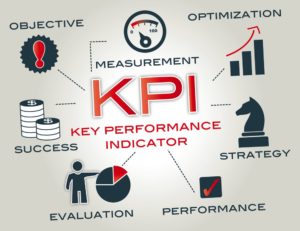
10 Effective Digital Marketing KPIs For Law Firms
 One of the many challenges of digital marketing is gauging whether your current strategy is working or not. Without using KPIs, or Key Performance Indicators, you will only be getting vague estimates and no clear picture if your firm’s goals are really being achieved.
One of the many challenges of digital marketing is gauging whether your current strategy is working or not. Without using KPIs, or Key Performance Indicators, you will only be getting vague estimates and no clear picture if your firm’s goals are really being achieved.
Tracking your online presence and trajectory using KPIs will ensure that you see the full picture. It will enable you to evaluate your strategies more effectively and adjust them when needed.
Digital marketing thrives on the proper use of KPIs because almost everything can be measured and quantified.
If you ask marketers, or search online, you’re sure to end up with long lists of potential KPIs that can quickly become confusing. The perfect set of KPIs for your law firm is going to vary somewhat depending on how you do your marketing and how you run your firm, but there are a few common KPIs that will give you a very good picture of how well your marketing efforts are paying off no matter how you run things.
1. Social Media Reach and Engagement
Social media is a haven for marketers due to the almost unlimited reach for virtually no cost. Tracking your social media reach will show you how effective your social media presence is. It tracks things such as likes, retweets, and shares. You are also able to connect how many leads are generated through social media reach and the percentage of traffic originating from each platform.
Tracking your social media reach will help answer the following questions:
- How many find your site through social media?
- Which content grabs people’s attention the most?
- Which social media platforms have the most conversions?
- Which social media platforms are worth the money?
2. Client Acquisition Cost
In digital marketing, there are potential customers and actual customers (or clients). Client acquisition cost shows you how much you spend to convert a potential customer into an actual customer. It calculates everything that you spend on attracting your target clients, from product cost to research and marketing.
It is always risky to under-budget by not measuring your data well. You have to know how much you actually need to spend to get the most conversions. It is ideal to evaluate your client acquisition cost after every campaign and adjust accordingly.
Tracking your client acquisition cost will help answer the following questions:
- How much do we spend on organic reach?
- How much do we spend on paid reach?
- How many leads converted in our campaign?
- How many leads became paying clients?
You can calculate CAC by dividing all business development and marketing costs by the number of new clients gained in a specific period.
3. Landing Page Conversion Rates
A landing page is distinct from your main website and is designed around a focused objective. Landing pages, to be considered effective, must generate conversions regularly. It must clearly communicate the action you want your leads to follow when they land on your website.
To show your visitors the path you want them to take, it is ideal to provide limited options. This will guide them towards whatever your intended goal is, whether it be buying a product or subscribing to your newsletter. This way, tracking becomes simpler.
Tracking your landing page conversion rates gives answers to the following questions:
- Are our leads doing what we want them to do?
- Is our message clear and concise?
You can calculate landing page conversions using a tool or by dividing the number of users who converted on your landing page by the total number of those that viewed the page. You can then multiply this by 100 to make it a percent.
4. Average Time of Conversion
This KPI tracks how long it takes for leads to convert into actual paying clients. It may seem trivial, but tracking the time will show how effective or ineffective your sales process is. If it’s taking too long to convert leads, it can mean that prospects are losing interest in your services and you lose them to your competitors as a result.
To alleviate slow conversion, you can promote time-sensitive discount offers to expedite sales. You can also create a remarketing calendar to consistently remind your prospective customers of your service.
Tracking your average time of conversion will help answer the following questions:
- Are we being time-efficient?
- Are we catching and holding our target audience’s attention?
- How effective is our sales process?
5. Cost per Lead
Just as it’s important to understand how much a new client costs in marketing output, it’s also important to understand how much a lead costs you. You can calculate this by taking your total marketing spend and dividing it by the number of leads you’ve acquired. You can do this month over month and year over year to get a thorough understanding of how beneficial your marketing is. You can get even more granular with this data by leveraging a customer journey analytics tool like the one HubSpot has. This will tell you which channels the lead came in contact with and from there you can understand how much you needed to invest in your marketing in order to acquire this lead.
6. Return on Investment
Return on investment or ROI is the most classic digital marketing KPI. This KPI lets you know if your investment in marketing is truly worth it. A negative ROI showcases that your marketing is not working well enough to justify your spend. You can calculate ROI by subtracting the initial investment cost from your final value then dividing this new number by the cost of investment. And finally, multiplying that by 100.
7. Pages per Session/ Average Session Duration
In order to understand if your website is engaging users you must look at more data besides how many sessions your website gets. On top of that, you should also look at how many pages users view in a session and what the average session duration is. Anything more than 4 pages per session is great, but lower than 2 is concerning. A solid average session duration is between 2-4 minutes. You can get more granular with this KPI by looking at these data points for each of your channels to see how engaged users are on your website based on which channel brought them there.
8. Click Through Rate
CTR showcases how many users have viewed an ad, email, or web page, and have clicked on a link after viewing your content. Most platforms for email, advertising, or website tracking showcase the CTR.
9. Keywords in Top 10 SERP
It’s important to have an understanding of how the keywords you’ve targeted are doing from month to month. A good indication that your SEO strategy is working is if you’re seeing more keywords ranking in the top 10 on search engines.
Related: SEO Basics in an Hour
10. Qualified Leads per Month
Sure, generating leads is important, but only if they are qualified. You can use your CRM software to categorize the different leads that come in and whether or not they are qualified.
Takeaway:
Tracking your KPIs will give you clear, actionable insights that will help you to build an effective digital marketing strategy that is responsive to both market trends and consumer behavior.
Are you unsure how your law firm can keep up with all this data every month and gain actionable insights from it? Our team can be of assistance. We’ve generated digital marketing reports monthly for many law firms and have helped them improve their marketing month over month through data analysis. Contact us today for a free consultation to get started.
Are you ready to get started generating new, qualified leads?
Contact us to get started and let us help you energize your digital marketing and business development efforts.
Contact Us

